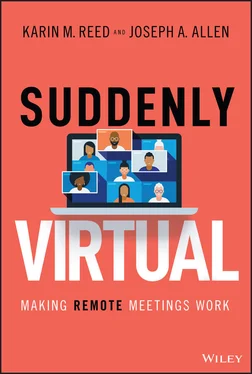CHAPTER 2 What Happened to Video Communication?: The On‐Camera Coach Perspective
“How often do you turn your webcam on when in a virtual meeting?”
For years, Karin has asked that question at the beginning of countless workshops focusing on effective virtual communication. Participants were given three options:
Never
Every time
Only when I see everyone else doing it
For many years, the top answer was overwhelmingly the same – “never.”
Since COVID‐19 and the mass migration to video collaboration tools, Karin has trained thousands of people on speaking through a webcam, and that formerly popular answer has changed dramatically. Only a handful of those in the post–COVID‐19 world respond that they never turn the camera on, and the number of people who turn the webcam on every time has steadily increased as the pandemic has worn on. However, the vast majority of workshop participants continue to opt for the third response: “Only when I see everyone else doing it.” They are responding to peer pressure for good or ill and not to the sound science and practice that suggests turning on the camera.
This small window into the adoption of video as a core component of virtual meetings is telling and reflective of a larger trend. Yes, more people are turning on their webcams than ever before, but there are still some barriers to adoption that hold back universal usage.
In this chapter, we will explore:
How video became a viable alternative to face‐to‐face interactions.
What value video brings to virtual meetings.
How video impacts remote workers.
Why video can be a critical element in meetings with external stakeholders.
Paving the Way for Virtual Video Communication
Video chat and collaboration did not arrive with COVID‐19. Rather, the earliest form of video chat appeared in 1927, when AT&T's Bell Labs debuted technology that would allow speakers to see someone in real time on a phone call. The one‐way TV demo call between then–Commerce Secretary Herbert Hoover and AT&T's President Walter Gifford sparked fascination but did not pave the way to public use, mainly due to a lack of network infrastructure.
In 1964, AT&T broke ground again with the introduction of the Picturephone at the World's Fair in New York City to much fanfare. However, a small‐scale rollout of the technology in 1970 did not gain the necessary momentum to make the Picturephone commercially viable. Attempts in the 1980s yielded the same results. The market was still reticent to shift from a traditional phone call to a video one, seemingly dooming video phones to a fate of failed innovation (Uenuma 2020).
It was only when the platform for video calls moved from phone lines to the Internet that video communication began to gain a foothold. In 1993, a University of Cambridge scientist connected a camera to the Web in an effort to monitor the department's coffee pot levels. He and his fellow scientists could check on those pots regularly online, which they did. However, to his great surprise, many other people did, too. His coffee pot cam in essence went viral (Kesby 2012).
The coffee pot cam could arguably be the genesis for a deluge of video communication innovation. Commercial webcams hit the marketplace. The “watery bloop” of a Skype call with its accompanying techno music became a familiar soundtrack for PC users in the early 2000s. But the real game‐changer was FaceTime on Apple's iPhone 4 in 2010, which prompted an endless string of software developers to create video‐based platforms for various mobile devices as well as desktops and laptops that normalized virtual video communication for the masses.
FaceTime and its cousins primed the pump for what would be one of the most extraordinary shifts in our history in the way we meet and conduct business communication.
Stay at Home becomes “Stay on Zoom”
In early April 2020, more than 90% of the population of the United States was under local or state “stay‐at‐home” orders (Chavez, Hanna, and Maxouris 2020). With face‐to‐face interactions out of the question for large swaths of the nation, people were hungry for ways to connect both professionally and personally.
In the early days of the lockdown, the focus was mostly on finding ways to connect with friends and family, and the quest largely ended with Zoom. The video meeting app was the number‐one free videoconferencing app on Apple's app store and experienced a 300% growth in daily usage by April 1 compared to the time before stay‐at‐home orders (Bary 2020). In just the first three weeks of April alone, Zoom added 100 million participants (Uenuma 2020).
Suddenly birthday parties, bridal showers, and book clubs were taking place on Zoom and other video platforms. While it couldn't provide an exact replica of an in‐person experience, it was pretty darn close, and the price was right – free. Besides which, the technology was relatively easy and usable even for those who had never used videoconferencing before. Lack of familiarity is one of the biggest barriers to adoption for any technology, and with so many people staying at home and staying on Zoom for all manner of reasons, people became more comfortable navigating the relatively intuitive interface in order to stay close but socially distanced in their personal lives.
In the workplace, though, Zoom had plenty of videoconferencing competition that was often already well‐established, if not utilized at high levels across the enterprise. WebEx, BlueJeans, GoToMeeting, and Microsoft Teams, along with many others, had established a strong presence in corporate America. However, many remote workers spoke of using the corporate platform when they had to but also of using a personal Zoom account when allowed by company policy. Some companies even found themselves using different platforms based upon the use case, for example, Zoom for training and Microsoft Teams for internal meetings, or WebEx for sales calls and Adobe Connect for internal presentations. This mix‐and‐match of multiple platforms presented its own challenges, which we will address in Chapter 12. Regardless of the software of choice, video communication had come into its own and opened up the eyes of new users to the benefits it could bring.
The Value of Video in a Virtual Meeting
Prior to the pandemic, the majority of the world was not a “webcam‐on” culture, even for those teams which were dispersed and worked remotely. While some organizations made it mandatory for employees to use video in virtual meetings, most left it up to the individual user to decide whether to have their camera on or off. It was not uncommon for duct tape or a sticky note to be placed strategically over the lenses of the built‐in cameras on laptops. Certain laptops already came with shutters that could be slipped over their built‐in cameras for privacy purposes – one more layer of protection against appearing unexpectedly on camera. Most people never expected, nor wanted, to be on camera.
The pandemic in essence ripped off the Band‐aid (or the duct tape) of webcam usage. Once face‐to‐face interactions became off‐limits, most people begrudgingly started turning their video on during corporate meetings, if only because they were told to give it a try. Soon enough, many video conference converts (by choice or by force) started to find the value that video can bring to virtual meetings.
Whether extroverted or introverted, humans are social beings. Taking away our ability to see others chips away at the very core of who we are, and strict social distancing can feel almost cruel to those who thrive on interpersonal contact. No wonder rates of depression have skyrocketed since the pandemic began. For humans, social interaction and social connection are understood as a core human need and the desire to connect is a fundamental drive (Baumeister and Leary 1995). Without it, humans experience distress, children experience developmental delays, loneliness creeps in, and adverse outcomes (e.g. aging, cardiovascular health risk, suicide, and mortality in general) become more common (Hawkley and Cacioppo 2010). Sure, a telephone call helps to lessen those feelings of withdrawal and isolation, but being able to see someone's face, even on a screen, adds a layer of connection that audio alone can't provide.
Читать дальше












